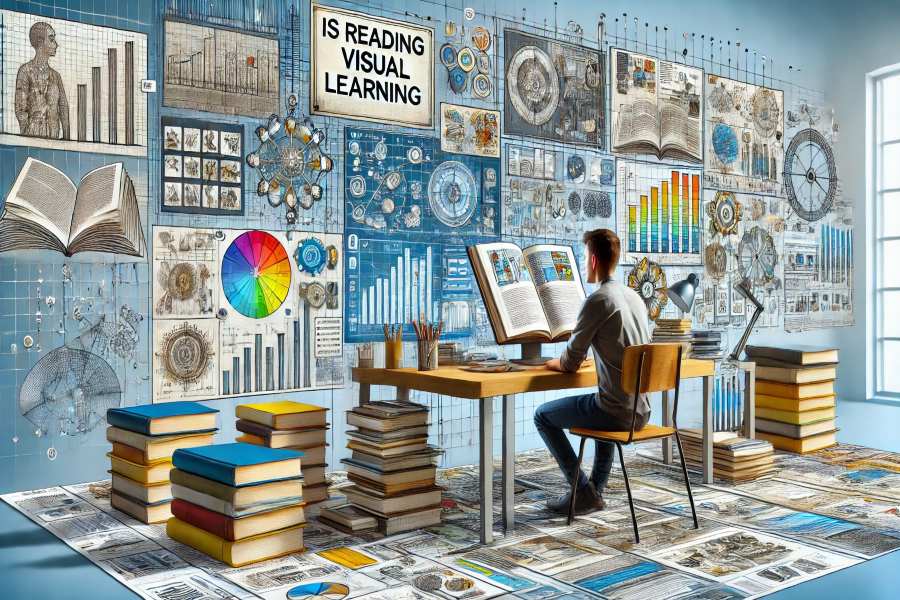In today’s fast-paced world, the methods by which we absorb information are evolving. With the advent of digital media, the debate between traditional reading and visual learning has gained momentum. Many wonder, “Is reading visual learning?” This question delves into the core of how our brains process written words versus visual stimuli. Reading, a fundamental skill, has long been associated with cognitive development and knowledge acquisition. However, with the increasing use of visual aids, such as infographics and videos, the landscape of learning is changing. Understanding whether reading falls under the category of visual learning is crucial for educators, students, and anyone interested in optimizing their learning strategies. This article explores the relationship between reading and visual learning, examining their similarities, and differences, and how they can complement each other to enhance comprehension and retention.
Is Reading Visual Learning?
Yes, reading can be considered a form of visual learning because it involves the visual processing of written words. While traditional reading relies on text, it activates the visual cortex, similar to how images do. Thus, reading and visual learning are interconnected, leveraging visual processing for comprehension.
The Nature Of Reading And Visual Learning
Reading is often perceived as a purely linguistic activity, but it inherently involves visual processing. When we read, our eyes scan the text, our brains decode the symbols, and we create mental images to understand the content. This process engages the visual cortex, similar to how we process images. Therefore, reading can be considered a form of visual learning, as it requires the interpretation of visual stimuli—letters and words—to extract meaning.
Visual learning, on the other hand, encompasses the use of images, diagrams, videos, and other visual aids to facilitate understanding. It capitalizes on the brain’s ability to quickly process and retain visual information. Visual learners benefit from seeing concepts and relationships depicted graphically, making complex ideas more accessible and memorable. The key difference lies in the medium used—text for reading versus images for visual learning.
Despite their differences, reading and visual learning share common ground. Both involve the use of visual processing to comprehend information. For instance, when reading descriptive text, readers often visualize the scenes and characters, enhancing their engagement and understanding. Similarly, visual learners may benefit from reading materials that include diagrams and illustrations to reinforce textual information.
Moreover, combining reading and visual learning can significantly enhance comprehension and retention. For example, textbooks often include charts, graphs, and images alongside text to provide a more comprehensive understanding of the subject matter. This multimodal approach caters to diverse learning styles and helps solidify the information in the learner’s memory.
The Benefits And Challenges Of Visual Learning
Enhanced Comprehension
Visual learning aids, such as diagrams and videos, can significantly enhance comprehension. By presenting information in a visual format, complex concepts become easier to grasp. For example, a flowchart can simplify a complicated process, making it more understandable. This visual representation helps learners see the relationships between different parts of the process, leading to better comprehension.
Improved Retention
Studies have shown that visual aids can improve retention. When information is presented visually, it is often remembered better than text alone. This is because the brain is wired to process and recall visual information more efficiently. For instance, a learner is more likely to remember a well-designed infographic than a page of text. The use of color, shapes, and spatial arrangements in visual aids can create strong mental images that stick in the memory.
Engagement and Motivation
Visual learning tools can make learning more engaging and motivating. They break the monotony of reading text and add a dynamic element to the learning experience. Interactive videos, for instance, can capture learners’ attention and keep them interested in the subject matter. This increased engagement can lead to higher motivation to learn and explore the topic further.
Accessibility and Inclusivity
Visual learning can also promote accessibility and inclusivity. For learners with reading difficulties or language barriers, visual aids can provide an alternative way to understand the material. Visual learning tools can bridge gaps in comprehension and make learning more inclusive for all students. This is particularly important in diverse classrooms where learners have varying needs and abilities.
Practical Applications Of Visual Learning In Education
Visual learning can be effectively integrated into educational settings to enhance student learning. Here are some practical applications:
- Incorporating Visual Aids in Textbooks: Use charts and graphs to explain data and trends. Include diagrams to illustrate complex processes. Add pictures and illustrations to provide context and visual interest.
- Using Multimedia Tools: Implement videos to explain concepts that are difficult to convey through text alone. Use interactive whiteboards to draw and manipulate visual representations of ideas. Encourage students to create their visual aids, such as mind maps and posters, to reinforce their learning.
- Creating Visual-Friendly Assessments: Design tests and quizzes that include visual elements, such as matching images to concepts. Use visual prompts in assignments to guide students’ thinking and creativity. Provide feedback using visual markers, such as highlighting key areas for improvement.
Alternative Perspective: The Limitations Of Visual Learning
While visual learning has many advantages, it is not without its limitations. One significant drawback is that not all learners are visually oriented. Some individuals may struggle to interpret visual information and may find text-based explanations more comprehensible. This highlights the importance of recognizing and catering to diverse learning styles within the classroom.
Another limitation is the potential for visual overload. Excessive use of visuals can overwhelm learners, leading to cognitive fatigue and reduced comprehension. It’s essential to strike a balance between visual and textual information to ensure that learners are not bombarded with too much at once.
Furthermore, visual learning tools can sometimes oversimplify complex concepts. While visual aids can make information more accessible, they may also strip away nuances and depth that are better conveyed through detailed text. This can result in a superficial understanding of the subject matter. Educators must be mindful of this limitation and ensure that visual aids complement, rather than replace, comprehensive textual explanations.
Integrating Reading And Visual Learning
1. Combining Text and Visuals in Educational Materials
Combining text and visuals in educational materials can create a more engaging and effective learning experience. For example, textbooks can integrate charts and diagrams alongside descriptive text, providing multiple perspectives on the same topic.
2. Encouraging Visualization During Reading
Encouraging students to visualize the content as they read can enhance their understanding and retention. Techniques such as guided imagery can help learners create mental pictures of the material, making it more memorable.
3. Using Technology to Enhance Learning
Technology can play a significant role in integrating reading and visual learning. Interactive e-books, educational apps, and online platforms can combine text with multimedia elements, offering a rich, immersive learning experience.
4. Tailoring Learning Strategies to Individual Needs
It’s important to tailor learning strategies to meet the individual needs of students. Some may benefit more from visual aids, while others may prefer text-based learning. By offering a variety of resources, educators can accommodate different learning preferences and ensure all students have the opportunity to succeed.
Conclusion
Understanding that reading is a form of visual learning opens up new possibilities for enhancing educational practices. By recognizing the synergy between these two methods, educators and learners can develop strategies that leverage the strengths of both. This holistic approach not only caters to diverse learning styles but also fosters a deeper, more comprehensive understanding of the material. Embracing this synergy is key to creating a rich and dynamic learning environment.
FAQs
Q1: Is Reading Considered A Form Of Visual Learning?
Yes, reading involves visual processing as it requires interpreting written symbols, which makes it a form of visual learning.
Q2: How Can Visual Aids Improve Reading Comprehension?
Visual aids can enhance reading comprehension by providing graphical representations of concepts, making complex information easier to understand and remember.
Q3: What Are Some Effective Visual Learning Tools?
Effective visual learning tools include diagrams, infographics, videos, mind maps, and interactive whiteboards.
Q4: Can Combining Reading And Visual Learning Benefit All Students?
Combining reading and visual learning can benefit most students by catering to different learning styles and enhancing engagement and retention.
Q5: What Are The Limitations Of Visual Learning?
Limitations of visual learning include the potential for visual overload, oversimplification of complex concepts, and the need to accommodate diverse learning preferences.












































Leave a Reply